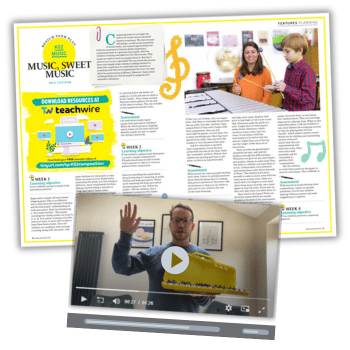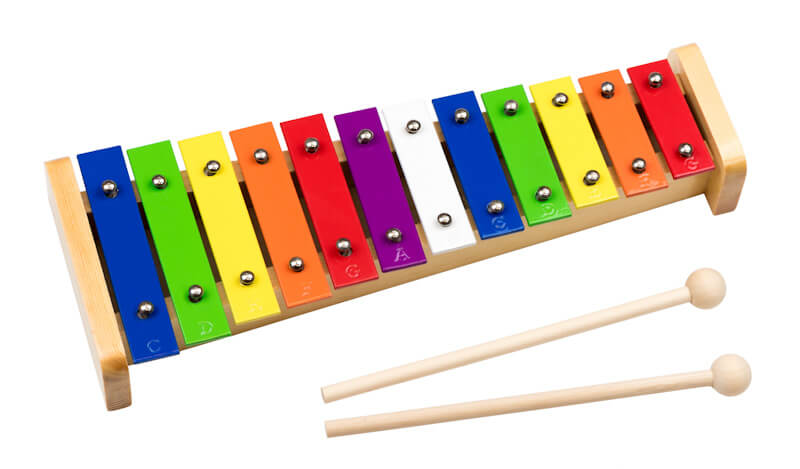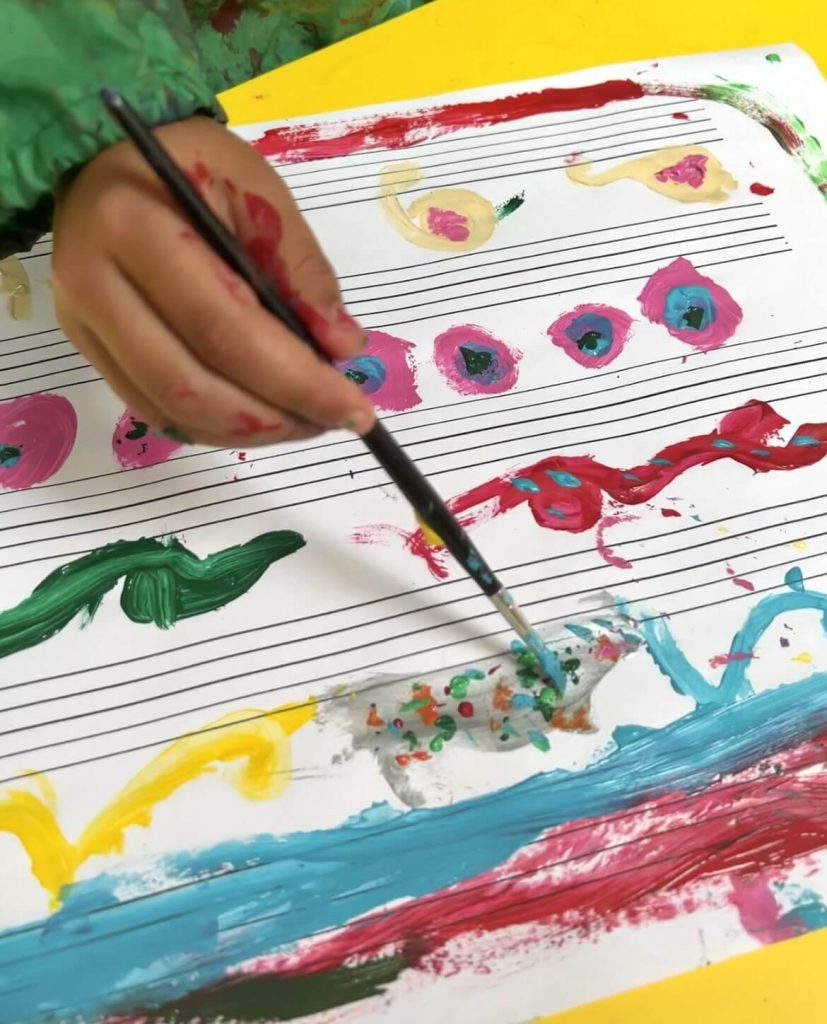Music national curriculum 2025 – Ofsted advice and practical ideas

Why is music in the national curriculum and what exactly do you need to teach? Find out here…

- by Teachwire
- Classroom expertise and free resources for teachers

Want expert advice about the music national curriculum and how to teach it? Look no further...
Music is a compulsory element of the national curriculum in England for all children up to the age of 14. The songs we learn at school often stick in our minds for a lifetime, demonstrating the powerful effect that music can have on us.
Looking for the music programmes of study for KS1, KS2 and KS3? Find them here.
- Why is music in the national curriculum?
- Latest Ofsted recommendations
- Music national curriculum overview
- How to teach music confidently as a non-expert
- Musical notation
- Musical instruments
- How to introduce tuned and untuned instruments to your class
- Primary school music lesson activities and ideas
- Music therapy and education
- Calming music for the classroom
- More resources for music
Why is music in the national curriculum?
Quality, child-centred music lessons at school can develop children’s brains, increase IQ and develop children’s ability to problem-solve.
Many studies have shown that high-quality musical learning has profound benefits for children in terms of wellbeing, academic achievement and the development of emotional and social skills.
The music national curriculum in KS1 and 2 says that music lessons “should engage and inspire pupils to develop a love of music and their talent as musicians, and so increase their self-confidence, creativity and sense of achievement.”
Why music education is important
Studies have shown that music activities in Early Years facilitate many different aspects of development and learning, providing one of the most effective influences on young people’s brain development at this key age.
Music is a multisensory experience and involves three ways of learning: visual, auditory and kinaesthetic. It has been shown to activate all three cortices (motor, visual and auditory) of children’s brains.
In fact, Anita Collins, a neuroscience and education researcher has described the effect of it as “like fireworks going off in the brain […] Music is a whole brain workout.”
Ofsted recommendations

Find out how your school can best adopt Ofsted’s music recommendations with this advice from Dr Liz Stafford…
No one enjoys an Ofsted inspection. So all power to the 25 primaries who volunteered to have inspectors visit them for the purposes of generating content for the Ofsted Music Subject Report, which was published in September 2023.
And thank goodness they did volunteer, because the result is a useful, practical, and realistic document for music advocacy and improvement.
The overall findings
The major news to note was that this report painted a comparatively rosy picture of music in primary schools – at last!
There is so much negativity about primary music on social media, and it often feels like primary schools are being unfairly blamed for all of secondaries’ woes.
The aspect of the music national curriculum that Ofsted praised most in the primary schools it visited was singing provision, which it acknowledged that primaries generally do better than secondaries.
However, it also noted that the teaching of composing was a weak area across both primary and secondary provision.
Ofsted articulates in this report that the schools with the strongest music provision organise their timetable on a weekly basis, ensuring that these weekly lessons are long enough to adequately cover the music national curriculum.
Practice time
Another aspect inspectors praised in the most effective schools was the use of practice time and feedback, which gives children the chance to improve their work, rather than just moving on to the next activity regardless.
They noted that the most successful schools were the ones whose curriculums were not full of short, chopping-and-changing topics. Instead, they focused on incremental learning of core skills through repetition of practical activities and content.
On the flip side, the inspectors found that many schools used content coverage as a shorthand for skills progression, focusing on completion of the music national curriculum in the time available as their main measure of success.
Teachers were also sometimes unable to offer the required feedback and modelling, due to their own level of musical confidence and skill.
Often the SLT had a good understanding of their staff’s areas for development, but there was no plan in place to address these, and so this issue was likely to perpetuate.
None of this is particularly surprising, of course, given that the majority of primary school teachers are not music specialists.
Neither is there an easy fix for this in the short, or even perhaps long term. However, Ofsted has had a crack at some suggestions which might help.
Primary school music: top-level recommendations
Ofsted recommends that schools take into consideration ‘precise endpoints in performance, composition and listening work’ when designing their music curriculum.
The aim here is to ensure pupils can progress step by step towards these goals. Curriculums should incrementally build ‘pupils’ knowledge of the technical and constructive aspects of music’.
They also – of course – recommend that schools set aside enough time to actually deliver this curriculum successfully.
In schools where music is led by a non-specialist, this process of designing a curriculum from scratch might be daunting.
Ofsted clearly recognises this because one of the other recommendations is to seek expert support when designing the curriculum, and provide specific support for subject leaders to ensure that the curriculum ‘deliberately and incrementally teaches all pupils to become more musical.’
If that sort of support sounds like it might be out of your budget, the report is favourable about the use of schemes in primary schools, when done in the correct way. So, a good alternative could be to buy in an expert-created scheme.
This might also help with Ofsted’s next recommendation: to implement the use of ongoing feedback and teacher demonstration to improve the technical and expressive quality of pupils’ musical responses.
Ofsted noted that the use of schemes with ‘accompanying instructional videos’ was a helpful element in giving staff the confidence to model and feedback to children on how to improve their work.
Additional responsibilities
Outside of the music national curriculum, Ofsted recommends that schools should make sure that they offer extra-curricular instrumental and vocal lessons. This is also an expectation of the National Plan for Music Education (2022).
In reality, with budgets in crisis, many schools will struggle to meet this recommendation. The network of local music hubs should be your first port of call to help you establish a cost-effective extra-curricular programme.
- Timetable music for an hour each week and ensure that it actually gets taught. Both Ofsted and the DfE keep nudging us in this direction, so we should probably all take note.
- Take a focused approach. For Ofsted, less is more, so cut down on the number of different instruments being taught, and approaches being taken, in favour of a consistent approach to the development of musical skill on a long-term basis.
- Take steps to upskill your staff. Whether it’s through a scheme with in-built CPD, a series of INSETs or some kind of training programme, show them that you understand your areas for development as a school and have acted accordingly.
- Review your composing and improvising provision. This is the area of the curriculum that Ofsted was most concerned about in this report, so it’s likely inspectors will want to look closely at it during a deep dive.
Dr Liz Stafford is director of education consultancy company Music Education Solutions®, editor of Primary Music Magazine, author of The Primary Music Leader’s Handbook (HarperCollins), and music specialist for Kapow Primary.
Music national curriculum overview
The primary music national curriculum for KS1 and KS2 covers the following:
- Singing
- Playing tuned and untuned instruments
- Listening to recorded and live music
- Composing and improvising
- Understanding music history
- Understanding notation
Teaching music in primary school requires facilitating children to “perform, listen to, review and evaluate music across a range of historical periods, musical genres, styles and traditions, including the works of the great composers and musicians”.
In order to fulfil these requirements – and satisfy a potential Ofsted deep dive – you need to make sure that through your music teaching you are covering each skill and element.
As Dr Elizabeth Stafford, director of Music Education Solutions, points out, when it comes to different types and genres, “the film music of John Williams, a song by The Beatles, the jazz of Miles Davis and the musicals of Sondheim could all be classed as being the very best of their respective genres and therefore worthy of study in their own right.”
End-of-Key-Stage expectations
The music national curriculum for KS1 and 2 doesn’t provide any structural advice for curriculum design beyond end-of-Key-Stage expectations.
It states that as pupils progress, they should “develop a critical engagement with music, allowing them to compose, and to listen with discrimination to the best in the musical canon.”
The music national curriculum aims to ensure that all pupils:
- perform, listen to, review and evaluate music across a range of historical periods, genres, styles and traditions, including the works of the great composers and musicians
- learn to sing and to use their voices, to create and compose on their own and with others, have the opportunity to learn an instrument, use technology appropriately and have the opportunity to progress to the next level of musical excellence
- understand and explore how music is created, produced and communicated, including through the inter related dimensions: pitch, duration, dynamics, tempo, timbre, texture, structure and appropriate musical notations
Key Stage 1 music programme of study and aims
The KS1 music national curriculum states that pupils should be taught to:
- use their voices expressively and creatively by singing songs and speaking chants and rhymes
- play tuned and untuned instruments musically
- listen with concentration and understanding to a range of high-quality live and recorded music
- experiment with, create, select and combine sounds using the interrelated dimensions of music
National Curriculum for KS2 music
The KS2 music national curriculum states that pupils should be taught to:
- play and perform in solo and ensemble contexts, using their voices and playing musical instruments with increasing accuracy, fluency, control and expression
- improvise and compose for a range of purposes using the interrelated dimensions of music
- listen with attention to detail and recall sounds with increasing aural memory
- use and understand staff and other musical notations
- appreciate and understand a wide range of high-quality live and recorded music drawn from different traditions and from great composers and musicians
- develop an understanding of the history of music
Music objectives KS2
In Key Stage 2, children should be taught to sing and play musically with increasing confidence and control. They should understand musical composition, organising and manipulating ideas within musical structures and reproducing sounds from aural memory.
How to teach music confidently as a non-expert
Sally-Anne Brown and Vic Holmes, directors of Note Weavers CIC, explain how to tackle this common problem…
We are regularly invited into schools to help teachers who lack confidence teaching music. What we always point out is that you don’t necessarily need to be a musician to teach music.
You just need to have an understanding of the importance of music in the classroom, resources you feel confident working with and enthusiasm. But that can seem easier said than done.
Music is not often given much priority in teacher training; understandably, perhaps, with so much to cover in the primary curriculum.
But this can mean that non-specialist teachers enter the profession with little or no music teaching knowledge, strategies or even resources.
“Music is not often given much priority in teacher training”
For those who may not have had a very positive experience of music themselves during their own school years, it can leave them feeling less than confident in their own teaching.
This lack of confidence non-specialist teachers may have in teaching music was also uncovered during the Department for Education’s review on music education, highlighting that there is a need for change.
So, what can we do to make music work in schools?
Know what your class can do
Understanding how children learn music at different ages will help make a lesson a success. So, first, let them play!
Allow young children to explore instruments and sound-makers themselves. With art, we allow our pupils time to paint and draw, and we acknowledge their efforts. The same is not always true of music.
Good quality, age-appropriate instruments are the ideal if your setting has access to the funding. But you can also offer a wide variety of sound-makers that your class can, and will, explore themselves, e.g. plastic mixing bowls, pans, wooden spoons, sponges, wire oven shelves.
Anything that has the potential for sound-making – the children will surprise you! Give them some time and space, then you can really observe what is going on. Next, move on to more structured activities.
Singing should be at the heart of music lessons in lower primary. When singing with young children, choose songs with small pitch ranges.
When modelling the songs, sing them slowly and at a higher pitch than you would normally, to match the children’s vocal ability. You can find plenty of free, appropriate resources on the National Youth Choir of Scotland website.
Being able to feel and find the pulse of a piece of music and keep a beat is essential. Disco music can be helpful in this regard, as it has a regular beat.
Let the children ‘find’ the beat, clapping along to it, then ask them to show other moves they can do on the beat.
Give children the opportunity to listen to a wide variety of music, including styles from different cultures. Visit mamalisa.com for great music from all around the world.
Don’t be afraid to repeat, repeat and repeat. Go over songs again and again until they are well established. You can then extend the activities by singing faster and slower, higher and lower, louder and softer.
Finally, make sure you record the children’s music to show progress.
Make some noise
Music, by its very nature, involves sound, but it doesn’t have to be ‘out of control’. If you are organising a music play time in your class, you could use quieter instruments or resources, tell classrooms nearby that you are having a music session and tell them how long it will last.
If the play is getting too loud, you can have a signal for the children to stop and listen, such as tapping a tambourine or a short whistle. For louder instruments, why not go outside?
Manage behaviour
Planning your lesson carefully will reduce the risk of behaviour issues. Choose appropriate repertoire and resources. Consider the purpose of each activity, so you are clear what you are using and why.
Allow for flexibility in planning so you can adapt and change plans to meet the needs of the children during the lesson. If an activity isn’t working, change it.
During both led and free-play activities, observe how the children engage and interact throughout.
Get extra support
There are many brilliant free resources available online to help sprinkle a bit of musical magic in the classroom.
We’ve worked with the BBC Teach team on its Musical Storyland resources. The music for these films has been written specifically for young children.
There are great melodies, repeated songs and chants, as well as plenty of opportunity for musical engagement. The learning resources have been designed so that everyone starts on a foundation level.
This allows teachers to assess how quickly children progress, and to move on only when they are ready to do so. The lesson plans are relevant for all nations across the UK.
Musical Storyland also introduces children to an array of musical instruments. The viola, horn, double bass and oboe have all been described as ‘endangered instruments’ by the Royal Northern College of Music.
Introducing children to these instruments will not only help to increase their awareness, but may even lead to a child deciding to learn one in the future.
Sally-Anne Brown and Vic Holmes are directors of Note Weavers CIC.
Musical notation
As discussed above, the music national curriculum for KS2 involves school students learning about musical notation (the way that songs are written down so players know the duration and pitch of the notes they are meant to play).
Each note is worth a certain amount of beats. Here are some music note names to explore with your class members:
- Semibreve (whole note – four beats)
- Minim (half note – two beats)
- Crochet (quarter note – one beat)
- Quaver (eighth note – half a beat)
- Semiquaver (sixteenth note – quarter of a beat)
Download our free frog- and tadpole-themed rhythm cards for teaching crotchet and quaver note lengths.
Musical instruments
When you were young, you may remember primary school musical instruments consisting of a few dusty glockenspiels and a maraca or two. Nowadays, if you’re thinking about buying musical instruments for kids at your school, the choice is much greater.
Ukuleles have replaced recorders as the musical instrument of choice in many primary classrooms. They are easy to use and have a pleasant sound that is popular with kids.
Ocarinas are also seen as an affordable and simple way to get a whole class playing tuned instruments.
Tuned percussion instruments such as xylophones and marimbas are a great way to cover the KS1 music aims. Use them to accompany the choir in your weekly singing assembly.
How to take control of instrumental lessons

Control the cacophony and get your whole class playing instruments in unison, while honouring the music national curriculum…
The last few years have seen the publication of multiple official music documents. These include The National Plan for Music Education, Model Music Curriculum (MMC) and the Ofsted Research Review. They created a buzz of discussion throughout the music community.
Each of these documents mention, some in great detail, the implementation and impact of whole class ensemble teaching (WCET). Specifically, they highlight the importance it plays within the music national curriculum.
Since 2017, I have been privileged to be part of this, delivering both brass and ukulele lessons within my school. So why should we be offering this opportunity and how do we inspire the next generation of musicians?
Instrumental lessons
The National Plan says that within KS1 ‘pupils should experience the mechanics of how instruments create sound, exploring simple class instruments, such as simple hand or tuned percussion and recorders.’
This should then be developed by the time they reach KS2. The plan suggests flute, violin and djembe as examples of what you can deliver.
The excitement I witness every week underpins how important this whole-class opportunity is for so many pupils across the country.
We should afford all pupils the opportunity to play an instrument, and make music alongside friends. It’s also one that we as practitioners should be facilitating. So how do we prepare for the task of coordinating 30+ children to play as a group?
Music national curriculum
The internet is awash with different schemes that will offer something different in every aspect. When considering your selection, look to see if you can you try before you buy.
All the major platforms offer a free option and, as budgets are precious, this is something I strongly advise exploring. Look at the additional aspects of these curriculums, too; can other classes benefit from the investment?
Additionally, other music teachers are now starting to develop great resources. I was fortunate to stumble across Mr Gray’s Music Shop and haven’t looked back since.
You will also find that the hubs across the country have developed guidance for their teachers and schools. Through a quick search you can locate YouTube channels and PDFs to support most instruments.
However, one size does not fit all and you will need to think carefully about your location and demographic.
What do you want as the outcome for your school? A mix of resources might be more appropriate than using just one scheme. Take time to consider everything before you commence with the lesson.
Music lessons
Singing, listening and performing are the key components for a successful lesson. The first session is all about exposure to the instrument.
Listening activities should feature different performers. Ideally, we want pupils to see what can be produced, and an overview of how that person started.
Our goal is to show it is possible to be like those who perform music. I regularly reference Alison Balsom, Jess Gillam, Alexis Ffrench, Wycliffe Gordon and many more in conversation, underpinned by examples of their performance.
I’m constantly reminding myself that I could quite easily have the next virtuoso brass player sitting in front of me. The first weeks of term are a key opportunity to embed the process and ensure everything is automatic.
Keep repeating processes to ensure everyone understands. My ukulele class were not the greatest fans of the Ukulele Magic – Ukulele Song, but after successive weeks of listening, all the parts were soon learned.
Other essential elements include:
Singing
Singing always features in every music lesson. Most primary schools have packed calendars over the year, so it is easy to select a limited repertoire.
However, supplementing this with other pieces will give children a broad variety of genres. Think about including pieces that are traditional, modern and from overseas.
One of the most popular pieces delivered in recent years at my school was Oranges and Lemons. Pupils thoroughly enjoyed learning it, especially supported by the playground actions!
Targets
Although exposure to multiple types of music is desirable, targets should be achievable. One or two pieces performed well is better than four or five fairly average ones.
It might be that throwing in multiple songs seems like a good way of keeping the interest up. However, in the long term the establishment of skills over a few pieces will have a greater impact. Therefore, it will a better performance for the class and school to enjoy.
You can help keep your children engaged with repeating a song by including short games and tasks. Focus on rhythm and pitch.
Recording
Record everything that you do, too; this is the greatest and most effective way to show progress. There are a variety of different secure platforms that can be used.
Seesaw seems to be popular among many schools, and Stream offers the opportunity to record straight to Microsoft 365. Essentially, whatever you do, have the evidence to share when it’s required.
Multi-sensory experiences
Lastly, don’t forget to ensure that what you deliver incorporates a multi-sensory approach. Often, I will use five strips of masking tape to act as a stave on the classroom floor.
When you are focusing on identifying notes, ask the children to step on the stave to show you the position of the note.
Equally, if you want to describe how music will ascend and descend in pitch, this an important way to demonstrate the process. It’s also much more interesting than just showing a piece of music with a series of black dots!
Nick Sermon is a class teacher and academy music lead. Follow Nick on Twitter @nicsermon.
How to introduce tuned and untuned instruments to your class
Deputy headteacher Ben Connor explains his tried and tested techniques…
These days, music is often taught through online schemes of work or portals that rely heavily on listening, responding to music, and singing.
There are many reasons why instruments are not used in the classroom, including a lack of teacher confidence or physical resources, and issues with planning or schemes of work. However, you can achieve a lot by implementing a few simple ideas and developing clear routines.
Tuned vs untuned
To start with, it’s important both you and the pupils understand the difference between tuned and untuned instruments.
Simply put, a tuned instrument, when played, can produce a melody or tune. It has keys, finger holes or strings that allow the musician to perform a melody, no matter how simple.
Examples within an orchestra include any instrument from the string, woodwind or brass sections, and some parts of the percussion section (xylophone, marimba, glockenspiel).
Examples in a primary classroom would be recorders, ukuleles, glockenspiels and chime bars.
An untuned instrument can be used to create a beat or rhythm, but not a melody. It’s often played through hitting with sticks, beaters, or hands and fingers.
Examples within an orchestra would be the majority of the percussion section (timpani, bass drum, drum kit). Examples in a primary classroom include wood blocks, claves, cymbals and tambourines.
Unless children are composing, lessons should be taught using either tuned or untuned instruments. Using both at the same time can be confusing.
Untuned instruments are best used when teaching about beat and rhythm, whereas tuned instruments are used to teach about pitch and melody.
Lesson ideas
When using any instruments, classroom management is key. See ‘Quick tips’ below for ideas on how to structure the start of an instrument lesson.
Once you have established how the creation of sound will be controlled by the teacher, it’s time to start using the instruments.
Untuned instruments
Beat
The beat is the steady pulse of a piece of music; I describe it to the children as the heartbeat. Music can be written with different beats to create a different feel to the music.
Most music is built around a four-beat pulse. Challenge the pupils to quietly play their instrument on the beats of the pulse.
Count the pulse aloud yourself to support and emphasise the first beat of every set. Once children have grasped the four-beat pulse (4/4), play them pieces of music which represent alternative pulses. For example:
- Two-beat pulse (2/2): Jingle Bells, Help by The Beatles
- Three-beat pulse (3/4): any waltz (I often play clips of Viennese waltz dances from Strictly Come Dancing!)
- Six-beat pulse (6/8): House of the Rising Sun by The Animals, We are the Champions by Queen
Tempo
The tempo is how slow or fast a piece of music is. Have children copy a simple beat pattern and change the tempo.
Play the beat slow, stop, then play it fast. Experiment with hand signals to change the tempo from fast to slow and vice versa.
Rhythm
The rhythm is a mixture of long and short notes which create a recognisable pattern. Once understanding of beat and pulse has been established, move on to rhythm and duration.
Ask children to play/hit their instruments once and listen carefully. How long before the instrument stops making noise? Can we make the sound last longer or stop sooner? How?
- Ask children to experiment with mixing long and short sounds to create a simple beat and rhythm.
- Play ‘Don’t Clap This One Back’ but have the children play/hit instead of clapping.
- Try a ‘call and response’ game, where one child is in charge and plays a short rhythm that the others have to copy. Rotate the lead role around the class.

Tuned instruments
Beat, pulse, tempo, rhythm and duration
All of the above can be taught/repeated using tuned instruments. The most effective, from experience, being the glockenspiel.
These are relatively cheap, can be shared one between two children and are simple to play. Recap some of the above activities before moving on to learning about pitch.
Pitch
Pitch is how high or low a note is, and is related to the frequency of a sound. The higher the frequency, the higher the pitch.
Simply put, the larger an instrument or key/bar of an instrument, the slower it will vibrate and the lower the frequency/pitch will be.
When introducing pitch, I always use a large xylophone. Play the keys from top to bottom/bottom to top, so that children can visualise that the lower notes make lower sounds.
Play a game of Low/Middle/High. Ask the children to close their eyes while you play a note on the xylophone; can they hear whether it is low/middle/high on the keys?
If school has a range of pitched instruments (hand bells, chime bars, etc), hand them out to a small group of pupils. Ask the children to play their instruments one at a time. Can they sort themselves into pitch order?
Quick tips for classroom management
1. Seven seconds of sound
When you first give out instruments, pupils will want to make a noise. From experience, they will do it whether you want them to or not.
It’s also important that children do get a chance to freely explore the sounds an instrument makes. So, give the instruments out, put your fingers in your ears and tell the children they have seven seconds to make as much noise as they want.
This gets it out of their system, ready for purposeful sound in the rest of the lesson.
2. Crowd control
Once the initial seven seconds of madness are over, you now need to establish hand signals for when you want pupils to stop playing.
Develop a clear routine, linked to existing classroom practices. For example, say, “When I hold my hand up, put all the instruments [or beaters] carefully down on the tables”.
Practise this routine to lay out your expectations and be clear about what happens if children don’t respond promptly.
3. Purposeful noise
Finally, explain the role of the conductor in a choir or orchestra: their role is to set the tempo and introduce the instruments at the correct time.
Split the class into groups. Have them ‘ready’, with beaters poised to play or instruments ready. They can only play when you ‘conduct’.
Point to each group in turn and have them play either one beat, or a simple rhythm. This gets the children used to playing at the right time.
Ben Connor is a deputy headteacher at a primary school in Bury, Greater Manchester. He is a trained music specialist and has been teaching for 13 years in various schools.
Primary school music lesson activities and ideas
Boost children’s musical knowledge by kicking off your next lesson with these music facts:
- Singing in a group has been proven to raise your mood. You release more feel-good hormones like oxytocin and less stress-causing hormones like cortisol.
- In 2015, the Canadian astronaut Chris Hadfield released an album that was entirely recorded in space.
- A tune that gets stuck in your head is called an “earworm”.
‘Dance’ with paint while listening to music

Blend the beauty of art with the joy of music with this upbeat KS1 idea from Adele Darlington, inspired by a Louis Armstrong masterpiece.
More simple ideas
Here are some simple ideas from Sue Newman, director of Boogie Mites Music Programmes, to develop children’s literacy skills through musical play:
- Explore pitch, tempo and dynamics in music. Sing a song high then low, fast then slow, loud then soft.
- Use instruments such as shakers, sticks and drums to keep the beat, or use actions such as marching, bobbing up and down, clapping or stamping.
- Tap out the rhythm (syllables) of words and music.
- Play along with different styles of recorded music with a strong drumbeat.
- Use the call-and-response method for leading sequences of vocal sounds, actions and instrumental sounds.
The following musical activity is based on Andrea Pyne’s ‘Don’t clap this one back’ idea:
- As the music teacher, clap a range of rhythms, no more than four beats long, using your hands, body, voice or the floor.
- Ask students to copy it.
- If the children hear the rhythm ‘don’t clap this one back’ in any form, they mustn’t copy it.
- If a pupil claps when they’re not meant to, you get a point. If no one claps when they hear ‘don’t clap this one back’, the students get a point. This is a great way for kids to practise their musical skills.
Mary Isherwood, headteacher at Camberwell Park School in Manchester, suggests the following music activities:
- Create ‘songboards’ using visual images to represent popular songs and ask children to choose their favourites.
- Put rhymes to familiar tunes to support young people with transitioning between activities.
- Using an instrument such as a bodhran, conduct a turn-taking musical ‘conversation’ with a pupil.
- Assign songs to certain auditory cues and use these to signify regular activities, such as assembly.
- Learn the signs to a set of favourite songs and have regular ‘sing and sign’ sessions with pupils.
Music therapy and education
As concerns about the mental wellbeing of school-aged children in the UK continue to rise, schools are increasingly turning to music therapy as a way to encourage self-expression and build self-confidence.
This powerful and enjoyable intervention can also help support pupils to reduce and better manage anxiety, making it easier for them to cope in the school context and, ultimately, enabling them to learn and succeed.
How it works
We know children can sometimes struggle to articulate their thoughts and feelings, especially if they have early trauma backgrounds. In such cases, music offers an accessible way for children to communicate and express their feelings effectively, without words.
Music therapy sessions are also very engaging and give children opportunities to express and process their experiences, thoughts and emotions creatively, within the safety of an attuned and containing therapeutic relationship.
Child psychologist Bruce Perry suggests that patterned, repetitive rhythmic activity supports regulatory processes, eliciting a sensation of safety and helping children to move from highly anxious to calmer states.
Therapeutic group drumming, a model often used within Chroma’s music therapy offer in partnership schools, can be especially motivational for children, not least as they tend to find it hard to resist playing along!
Drumming in a group context with peers can build conflict resolution skills through teamwork. It encourages positive social interactions, often with playfulness at the centre, through greater verbal and non-verbal communication.
Drumming in this way can help reduce anxiety, and provide opportunities to explore and create a cohesive network of positive connections for children in school, promoting mental wellbeing and a sense of belonging.
Therapy in action
Chroma recently began delivering therapeutic music group sessions at Marland School in North Devon to support pupils with social, emotional and mental health needs.
Using djembe drums, the sessions incorporate a variety of structured activities that focus on establishing group beats and collaboration.
These include passing individual rhythms, maintaining a group pulse, and increasing and decreasing the volume and tempo of play — all to instill a sense of belonging, coherence and value in the group.
Djembe drums are played using hands, rather than sticks or beaters, so the offer is highly accessible. It’s is especially beneficial for children who have low self-worth or a fear of failure.
How the sessions work
Children work proactively during these sessions, agreeing guidelines to determine how they want to complete the exercises together.
While we suggest activities, pupils can bring their own ideas. And, to create a sense of empowerment, at planned end points the children have opportunities to showcase their group and individual progress, promoting their ownership of, and pride in, the work.
We actively encourage teaching staff to participate, too. This provides them with a valuable opportunity to observe the children in a different context, and connect positively with them outside of a formal classroom environment.
The group sessions develop cohesion through familiarisation, and gradually reduce pupils’ anxiety through increased attendance, participation and engagement levels.
They also provide opportunities to experience and develop regulation through those processes. Activities led by trained music therapists safely expose children to aroused states for short durations before moving back to a calmer state.
This alternation between settled and aroused states can help their bodies to move out of fight and flight states more naturally.
Expressing oneself can be a struggle for adults, so it’s easy to imagine the difficulties young children may face in self-expression, particularly when early trauma has occurred at the pre-verbal stage.
Incorporating therapeutic drumming sessions into their school life will not only provide pupils with a safe space to effectively express themselves in a fun, creative way, but will also help them to grow emotionally and socially.
Lucy Collings Pettit and Adele Bird are music therapists at Chroma.
Calming music for the classroom
As headteacher Mary Isherwood points out, music can be a motivator and a reward. It can be calming and relaxing in some situations and stimulating and engaging in others.
The key to using music effectively is to know your students well, and what you are trying to help them to achieve.
Search YouTube for ready-to-go calming playlists and use them when children are doing independent work or during meditation sessions. Classic FM recommends the following pieces of relaxing classroom music for children:
- The Swan – Saint Saëns
- Air on a G String – Bach
- I Giorni – Einaudi
- American Beauty – Thomas Newman
More resources for music
- If you’re looking for a fun song for kids to sing to start off the new school year, we’ve got free sheet music for piano and vocals, an audio backing track and lyrics sheets.
- Combine music and Spanish language skills in KS2 with this series of short activities for children based around The Carnival of the Animals by Saint Saens.
- Charanga Music features a large library of resources, songs, instrumental courses and creative apps.
- Music Express is a digital primary resource.










